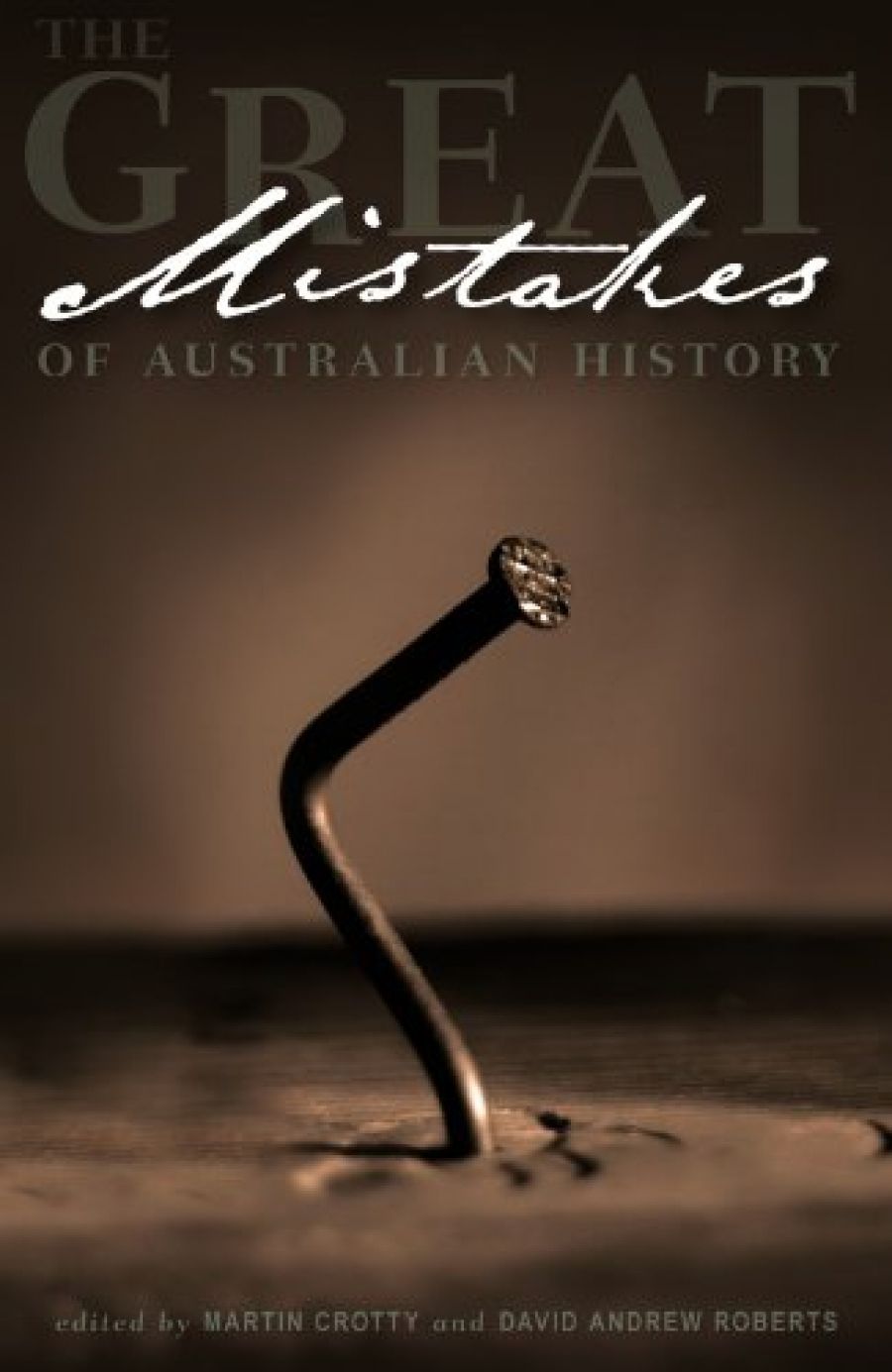
- Free Article: No
- Contents Category: Australian History
- Review Article: Yes
- Online Only: No
- Custom Highlight Text:
The trouble about identifying great mistakes in Australian history is that most of them seemed like good ideas at the time. When, for instance, a recent IPA Review identified as one of Australia’s major errors the rejection in 1905 of George Reid’s free-trade federal government in favour of Alfred Deakin’s tariff protectionists, it indulged in anachronistic hindsight. However suited globalisation may be to the geopolitics and technology of the present day, things were different a hundred years ago. Every nation except Great Britain and Turkey used the tariff to protect local capitalists and employees. A whole anthology of ‘great mistakes’ risks deteriorating into a facile exercise in ancestor-bashing.
- Book 1 Title: The Great Mistakes of Australian History
- Book 1 Biblio: UNSW Press, $34.95 pb, 247 pp
Fortunately, Martin Crotty and David Andrew Roberts have chosen an able team of authors, who largely avoid this trap. In the first chapters, Roberts and Peter Read deal with the failure of the first generation of New South Wales settlers to recognise Aboriginal rights. Unlike most other colonised peoples, who were recognised as owning some kind of equity in their native lands, the Aborigines were regarded as ‘especially unworthy of reasonable treatment’ because their social and cultural organisation did not meet European preconceptions. This first fatal error remains to shape modern perceptions. State and federal governments still resist judicial assertions of native title, although North America and New Zealand have ventured down this road. John Howard has yet to apologise for the coercive removal of Aboriginal children from their parents and culture.
Four more essays cover a wide range of environmental issues. In two of the subtlest and most perceptive chapters, Alan Atkinson muses on trial and error in the exploration of Australia, and Richard Waterhouse summarises the agrarian experience of imposing a yeoman myth on an unresponsive environment. Greg Baxter and Manda Page, on the ecological damage caused by introduced fauna and flora, take us over ground previously covered by Eric Rolls in They All Ran Wild (1969). Paul Ashton’s discussion of the Cahill Expressway as a monument to inept urban planning strikes me as a fresher perspective.
Three chapters concern themselves with Australia’s experience of war. Crotty wrestles with understanding the naïve militarism with which Australians joined World War I. He does not argue that it was a mistake to participate, only that press, pulpit and public shared unreal and sanitised ideas about what happens in war. All too readily they embraced the myth that war was a cleansing and ennobling part of graduating to nationhood. A century ago, these were commonplace beliefs in much of the world, but they seemed especially beguiling to a nation that owed its creation to a bunch of middle-aged lawyers and politicians – and they still have power. It is a fair bet that the centenary of Gallipoli in 2015 will be celebrated with greater public enthusiasm than the centenary of Federation in 2001. Crotty is right to call for realism about war. Perhaps realism comes easier in this age of television and the Internet, but the digger myth is still ineradicably potent.
Both David Day and Ilma O’Brien write with an eye to the present. Day tells how Britain and Australia colluded in accepting that Singapore would prove a sure barrier to potential aggressors until proved wrong in February 1942. Moral: don’t place too much trust in the judgment of great and powerful allies. O’Brien denounces the indiscriminate internment of ‘enemy aliens’ in wartime. Moral: governments should not be panicked by war or terrorism into demonising ethnic minorities and cutting corners on human rights. But, as the cynic said, history, especially government policy which becomes the stuff of history, is made by people who seem never to have read any.
Four somewhat miscellaneous chapters on trade and politics conclude the anthology. Marian Diamond looks at the possibility that in the nineteenth century a multicultural northern Australia might have made for greater racial tolerance and averted the White Australia policy that has proved hard to live down in recent times. Maybe, maybe not; it is hard, in this era when jobs are exported offshore, to argue that working-class fears of the competition of cheap non-European labour were totally irrational, though they led to some deplorable prejudices. Clive Moore ranges over a wide field to show how the federal constitution of the 1890s might have been framed better to suit the need of later Australians. Writing in the week when the High Court handed down its verdict on the Commonwealth’s powers under Section 51, it is easy to accept Moore’s insight that the flexibility of the judiciary in changing legal interpretations has papered over any need for substantive or fundamental change. Klaus Neumann, writing about the forced removal of non-Europeans from Australia between 1945 and 1949, reinforces many of O’Brien’s points. They had Arthur Calwell; we had Philip Ruddock. Wayne Reynolds revisits the 1975 constitutional crisis to show that neither Gough Whitlam nor John Kerr got their constitutional history right.
These political chapters raise questions for democracy. Most of the mistakes listed by Crotty and Roberts gained public acceptance. Is it a mistake to enforce policies that are probably supported by the majority of voters? If it is, in what circumstances is a government minister entitled to conclude that his or her view of Australia’s long-term interests should override democratic opinion? Perhaps mistakes are avoided only by inertia. Or perhaps mistakes can become a useful part of Australians’ collective learning experience. May we cherish a wistful hope that the decision-makers of our own day will be sobered by reading about the mistakes of the past?


Comments powered by CComment